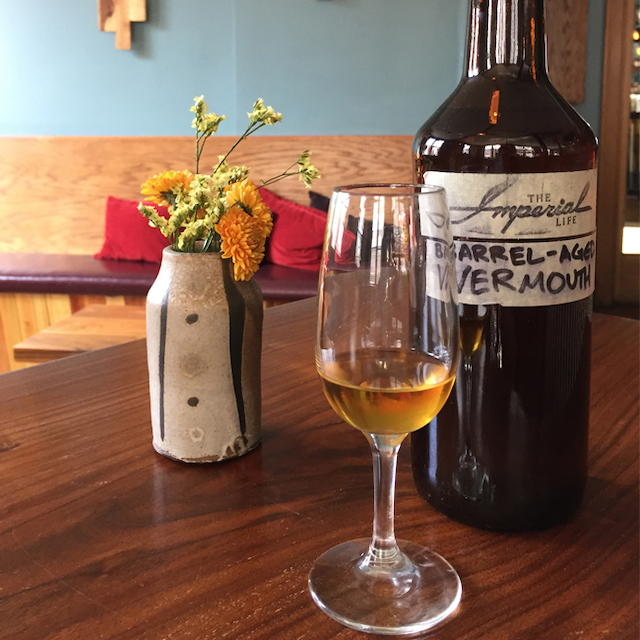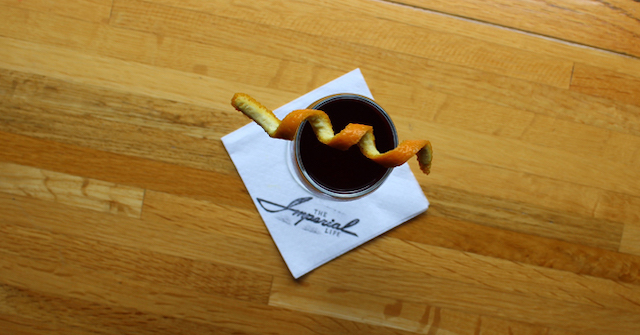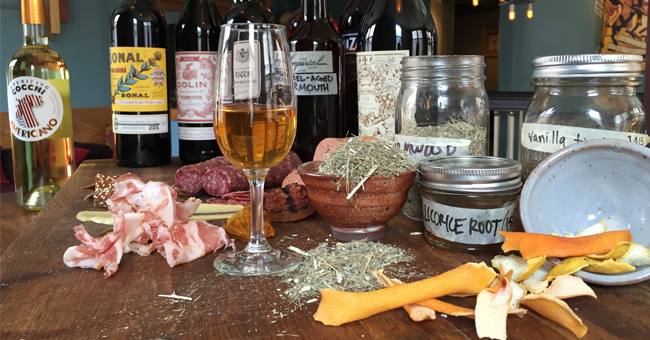Although the North Carolina mountain town of Asheville has long been known for its food scene, it is increasingly becoming a destination for cocktails as well. And the Imperial Life, which is upstairs from one of the city’s most beloved restaurants, Table, is at the forefront of the small city’s evolving craft cocktail movement.
“It’s a pretty tight-knit community of bartenders, learners, and tinkerers,” says bartender Teddy Bourgeois. Bourgeois is more than well-versed in the history of spirits in the South, as he’s pursuing a master’s degree in Appalachian Studies with a concentration in Sustainable Development at Appalachian State University.
What makes the Imperial Life unique is its focus not only on cocktails, but also on “celebrating” all things cured, pickled, preserved, and raw. General manager and bartender Jasper Adams says that the culinary philosophy of Jacob Sessoms, chef and owner of Table – to source food locally and do as little to it as possible – also extends to the Imperial Life’s charcuterie and vermouth programs. In fact, you might say that the approach of the Imperial Life is about as local as you can get: these signature offerings are prepared in the basement of the building.
When I sit down at the bar on a quiet Sunday evening, I can hear the faint sounds of cars passing and people chatting on the street below. Outside, the air is cool, and the autumn leaves have begun to fall. It’s an ideal evening for a classic Manhattan or a barrel-aged boulevardier that involves a combination of their house vermouth and Cinzano Rosso.
 The Imperial Life’s housemade vermouth, made with white wine and an array of botanicals, is part of its commitment to preserving food and drink.
The Imperial Life’s housemade vermouth, made with white wine and an array of botanicals, is part of its commitment to preserving food and drink.
The cocktail menu at the Imperial Life has several excellent vermouth-oriented offerings: the Kilted Pear, a whiskey cocktail with Dolin Blanc, Clear Creek Pear Brandy, Luxardo Maraschino, and orange bitters, and the Central Grocery, a gin cocktail with Carpano Bianco and Antica Formula, and Herbsaint. Bourgeois also serves me one of his own specialities, a New Leicester made with their vermouth, cognac, Angostura bitters, Peychaud’s bitters, and Green Chartreuse. It is a perfect cocktail for a fall evening.
At $9-12, the cocktails are less expensive than their big-city counterparts, as are the charcuterie boards ($6 for one person; $11 for two; and $16 for three). The bar menu also includes a unique variation on a classic: pigs in a blanket made with house-made hotdogs and puff pastry ($5). “Those little snacks are among the most labor-intensive in the restaurant, as they’re ground three times before they are cased,” says Adams. “The process takes three days.”
They are hot dogs to be savored.
Bourgeois and Adams note that their charcuterie and sweet vermouth pair well because both are made in the same place, by the same people, and with the same key ingredients. But their own vermouth is only one of many options available at the Imperial Life. The bartenders work with as many as fifteen different types of vermouth. “We’ll choose vermouths based on what sort of flavor we’re looking to add to a particular cocktail, so if our house vermouth is the one that works, that’s the one that works,” says Adams. Cinzano Rosso is a drier option, with flavors of savory spice, oregano, and rosemary; Carpano Antica Formula and Cocchi Vermouth di Torino have a sweeter viscosity. Their own vermouth has a sweet viscosity and a rich caramel flavor that comes from burnt sugar.
Vermouth is part of the bar’s commitment to preserving food and drink. “The process of making vermouth starts with white wine – whatever we have – so each batch is slightly different, although the through-line is the botanical formula,” says Bourgeois. “When we’re making a larger batch, we’ll purchase wine in advance in order to make it, but mostly we take wine that’s open in the restaurant, we dump it in the bucket, and then we add everything else to it.” The botanicals might include wormwood, gentian, chamomile, angelica, sarsaparilla, rosemary, sage, vanilla, quinine, cinnamon, and clove, as well as dried grapefruit, lemon, and orange peel. Less than five grams of botanicals go into each of the five-gallon barrels from Tuthilltown Spirits Distillery in Gardiner, New York in which the vermouth is aged (https://www.tuthilltown.com/).
Like vermouth, charcuterie is a way of using food that would otherwise spoil. And the program is always trying new combinations and approaches under the guidance of Patrick Rumley. The flavoring agents for charcuterie can be as simple as salt and pepper, but they might also involve nutmeg, clove, and fennel. Rumley first trims whole muscles such as coppa into shape for salting. They are then rotated, re-salted, washed and spiced (often only with black pepper), stuffed into a beef bung, tied with butcher’s twine, and hung in the drying box. It can take up to four months for coppa to lose 35-40% of its moisture.
Then it is up to the chef on duty at the Imperial Life to create a balanced and nuanced charcuterie board that also includes house-made pickles (some deliciously spicy), and for the bartender to help you to a great pairing.
Chef Quin Soemardi presents me with a selection of all three of the raw delights prepared in-house: a whole muscle, cured charcuterie sliced very thin (coppa); an Italian fennel salami fermented and dried (finocchiona); and an emulsified sausage (mortadella) prepared not with the standard large cashews, but simply with a spice blend and whole black pepper. “We whip air into it,” he says. “That gives it a really nice, rich creaminess.”
You can’t really go wrong with pairings, say Adams and Bourgeois, but if you want to be more particular, that’s fine, too. “If you have a whole muscle cure, it’s more or less just salt and pepper, and it has really awesome, buttery, fatty bits like you see in prosciutto or lardo, so a vermouth to cut that fat – something that has a little bit higher acidity perhaps and a little bit of bitterness – is going to work really well,” says Adams. “With a mortadella that has a little bit of nutmeg, clove, salt and pepper, and is a little more homogenous in flavor, you can go a little more austere on the vermouth end because you don’t need to cut it with a big flavor.”
Like other vermouths, the Imperial Life’s house-made vermouth is not only a cocktail modifier; it also pairs nicely with charcuterie on its own. This is how vermouth was consumed in Italy in the late 1700s: on ice and with a spritz or peel of citrus, if you had those luxuries. Luckily, Asheville does.rn
Cocktails for the Vermouth Lover
The Kilted Pear (by Jasper Adams)
-
- 1 oz. Famous Grouse Blended Scotch Whisky
- 1 oz. Dolin Blanc Vermouth
- .25 oz. Clear Creek Pear Brandy
- 1 barspoon Luxardo Maraschino
- 1 dash Regan’s No. 6 Orange Bitters
Add ingredients to a mixing glass and stir over ice. Strain into a chilled martini or coupe glass. Garnish with a pear slice.
The Central Grocery (by Ben Johnson and Teddy Bourgeois)rn
-
- 1 oz. Citadelle London Dry Gin
- 1 oz. Carpano Bianco Vermouth
- 1 oz. Carpano Antica Formula Vermouth
- 1 barspoon Herbsaint
Add ingredients to a mixing glass and stir over ice. Strain into a chilled martini or coupe glass. Garnish with a lemon twist.
The New Leicester (by Teddy Bourgeois)rn
-
- 1 oz. Pierre Ferrard cognac
- 1.5 oz. house-made, barrel-aged vermouth
- 2 dashes Angostura bitters
- 2 dashes Peychaud’s bitters
- 1 barspoon Green Chartreuse
Add ingredients to a mixing glass and stir over ice. Strain into a chilled martini or coupe glass. Garnish with a lemon twist.
 At the Imperial Life, bartenders work with as many as fifteen different vermouths, and integrate a range of vermouth types into their cocktails.
At the Imperial Life, bartenders work with as many as fifteen different vermouths, and integrate a range of vermouth types into their cocktails.




